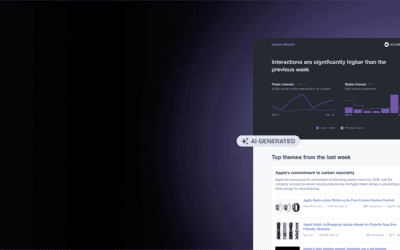On Friday, July 8th, 2022, Rogers Communications accidentally shut off its customers’ cell phone, Wi-Fi and cable service for 24 hours, resulting in a PR disaster for the Canadian telecom giant. We asked communications and crisis management expert Lloyd Rang — President and Narrative Lead of Curious Public — to share his thoughts on the lessons communications professionals can learn.
“Rogers is Canada’s biggest telecommunications company and has 11 million subscribers. When they went dark, so did millions of Canadians. For the UK, that would be like BT, Vodafone, and Three all shutting down at once – pausing all internet traffic, electronic purchases and banking,” said Rang. “Obviously, that’s bad. But the response was even worse.”
Over four thousand articles have been published about Rogers in the last month. But over 60% were published in the three days of the crisis (Friday, Saturday, and Sunday.) Top publishers were The Beaverton, Global News, and City News, with authors Tara Deschamps, Rachel Gilmore, and Ian McIntyre penning most stories, which received 460,000 audience engagements. Most of the news had to do with the poor way Rogers communicated about the issue.

“In fact,” says Rang, “Rogers’ flatfooted communications didn’t just make matters worse, it reinforced negative perceptions.”
Rang describes 5 lessons that PR professionals can take from this event:
1. Preparation Is everything in a crisis
Companies only have so much banked goodwill. In Rogers’ case, they were already close to an overdraft with Canadians.
This current outage came on the heels of another in April of this year, which coincided with the company raising prices for most of its services. And this was swiftly followed by the company pressing forward with a proposed $16-billion deal to purchase Canada’s fourth-largest communications and media company.
With public perception so low, Rogers couldn’t afford another crisis and should have been prepared. The communications team should have taken stock, built a contingency plan, and gone through a pre-mortem to mitigate future problems.
As a comparison, the US company CenturyLink experienced a similar outage in a period of three days. In its outage, CenturyLink garnered 1.7k articles and 162k interactions.

“If Rogers had studied their American counterpart, they may have been better able to measure the magnitude of this crisis,” says Rang.
2. Companies can’t go mute
For most of Friday’s outage, Rogers said nothing, leaving Canadians to speculate the worst. Were they hacked? Was their data safe? How big was the problem?
As Rang points out, Communications 101 dictates that when a crisis breaks, you need to grab someone, run a comb through their hair, and get them on TV dispelling rumors.
Rogers; CEO Tony Staffieri eventually made a statement the following day. But for anyone playing along at home, that’s approximately 23 hours too late.
3. Own how It looks
Instead of a press conference, a public statement – or anything – Rogers sent out Tweets.
The irony is that the tweets could only be seen by non-Rogers customers, leading to floods of online jokes that Canada’s biggest telecoms company must have used a competitor’s services.
“The opportunity was wide open for the company to own the obvious with some humor or, at the very least, explain it,” says Rang.
Communicators can’t ignore the larger realities of a situation – or how they are getting their message to audiences.
4. Give consistent and truthful updates
Even if a company doesn’t have all the answers, getting a qualified spokesperson out in front of cameras to answer questions creates confidence – but only if the updates are true!
“Rogers chose to say that services had been restored for “virtually everybody,”” says Rang. “But many people pointed out the falsehood of that statement online. That word choice was mystifying at best and misleading at worst.”
5. Don’t leave the price of goodwill to the accountants
Rogers tried to make things right with customers, saying they would proactively credit accounts for Friday’s outage. But they still haven’t named a price. During the April outage, they credited customers for the equivalent of the day’s service fee — a paltry sum.
Based on the last rebate, customers are already taking to social media, speculating on just how little they’ll receive.
“Be clear in communications and generous in the refund,” says Rang. “Anything less isn’t worth the data you Tweet it on.”
The real communications failure
Ultimately, Canadians have seen little empathy from Rogers or any understanding of how the crisis impacts lives. As news reports have been rolling in about parents unable to call ambulances for their children or the senior members of their families, Rogers’ messaging has been consistently lacking.
“Trust,” says Rang, “Is a fragile commodity. Break it, and customers will run straight into the arms of the competition. The only way to win it back is to be honest, generous, empathetic, and human.”











